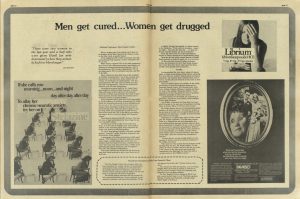Accompanied by advertisements for common prescription tranquilizers such as Stelazine, Librium, and Pavabid, an article by Michael Castleman of the Free People’s Clinic in the April 1974 issue of Her-self shares statistics that reveal the extent to which women, on average, take tranquilizers more than men. According to Castleman, “of the staggering 40% of adult Americans who take mood-altering drugs regularly, women outnumber men two to one” (12). To explain why women are consuming drugs at a higher rate, Castleman cites a study by Dr. Lind Fidell, a psychologist at the California State University at Northridge. Dr. Fidell finds that, “physicians tend to take their male patients’ symptoms of illness more seriously than those of their female patients,” who were more often stereotyped as hypochondriacs, and that 75% of ads for mood-altering drugs in the magazine Modern Medicine depicted women as likely beneficiaries of medication, convincing psychiatrists to target women (Castleman 12).

An article, “Men get cured… Women get drugged” by Michael Castleman, published alongside ads for prescription sedatives in the May 1976 issue of Her-self. In the article, Castleman shares statistics on tranquilizer abuse that reveal that addiction is a feminist issue.
The inclusion of these and similar statistics supports the stories of women, and illustrates with concrete data the dangers of prescription tranquilizers. Castleman concludes the article with his observations of similarities between ads for tranquilizers: “all of these ads have strong Freudian overtones: women are hysterical; it’s all in their heads; women can’t cope; they don’t know what’s good for them [but] luckily, their god-like male doctors do” (13). Juxtaposing ads and statistics that undermine them, this summation by Castleman, an expert in the medical industry and advocate for patients rights, reveals the misogynistic tactics of the pharmaceutical industry – from drug company to psychiatrist – that convince women that the cure is always a company’s tranquilizer.
Work Cited:
Castleman, Michael. “Men Get Cured… Women Get Drugged.” Her-self, vol. 3, no. 1, Apr. 1974, pp. 12-13. JSTOR, www.jstor.org/stable/community.28038343.
